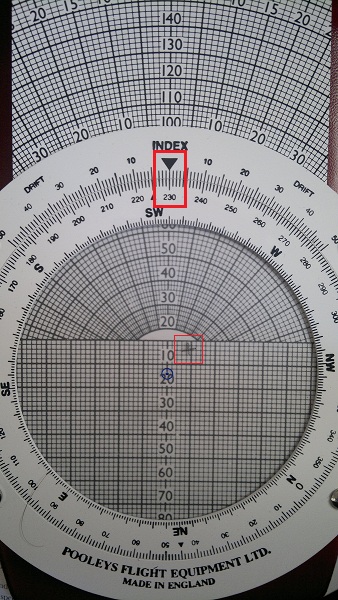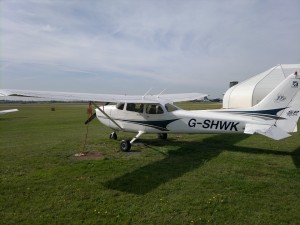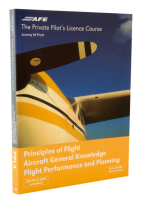As it was my birthday I decided what better way to spend it then to go flying all day long, so I’d booked in for two lessons on the same day (each lesson is a two hour slot, so other than a spot of lunch in the middle for 4 hours of the day you’re either checking a plane, talking about planes or flying the plane 🙂 ). There really are worse ways to spend a weekend….
Briefing
We went through the calculation for working out the crosswind component.
There are many ways to do this, the technically most accurate is:
XWind = WindSpeed * sin(WindDiffAngle)
Where “WindDiffAngle” is the difference between the runway angle and the wind angle, assuming you want the crosswind component of flying into that runway. Good luck trying to remember your sine tables while somewhere in the circuit or on approach to an airfield.
Lets say the runway is 23 (230 degrees), and there’s a crosswind from 270 at 14 kts.

Calculating Crosswind Component
Because a Flight Computer (the UK mandates use of a mechanical version, which for me is stretching the bounds of what you should be allowed to call a “computer”), is essentially a circular slide rule, it can do this equation for you. Well sort of, because it’s mechanical its solution is that you set the circular part to the wind direction, then mark with a pencil the wind speed. Then as you rotate the circular part to the runway direction, your pencil mark will move, giving you the final crosswind component for that runway (I can’t wait to try and do all that faffing in the air!)
Mechanical flight computers lack precision and are exposed to the mercy of human error, most of the time you just want a ball park figure anyway – especially when you’re busy doing the top priority of ‘aviating’ in the circuit.
There are many schemes for getting in the ball park, arguably the simplest is the “Clock” rule of thumb.
Quite simply, draw a clock with 60 at the top, 30 at the bottom etc. Now take difference between the runway and the wind direction (in the above example: 270-230 = 40). 40 is two thirds of 60, so the crosswind component is roughly two thirds of the wind speed – so in our example, 14kts * 0.666 = ~9.32 kts.
If we used the equation to compute this we’d get: (14 * (sin(40)) = 8.99 kts
So the rule of thumb method has an error of 0.33 kts (for this scenario, the rule has a huge 13% error at 60 degrees), but it gets you in the ball park. You don’t need to worry too much about that big error at 60 degrees difference between runway & wind direction, because the clock rule of thumb is pessimistic. It will result in you multiplying the reported wind by 1, instead of 0.87, this will give you an answer with a higher crosswind component then there actually is.
Look closely at the image of the flight computer, the pencil mark is now showing maybe 8kts or maybe 9kts of crosswind. As I said above, being mechanical, they lack precision and this lack of precision comes from: How thick was the pencil? and the tolerance spacing between markings of 2kts per box. Still, it’ll do the computation.
Taxi to Delta…..to where?

G-SHWK
Flying G-SHWK, if the weather hadn’t been so bad the month before I’d hoped to have made this set of lessons the one where I went solo. However, it was unlikely now, especially as the last lesson had ended with a need to see a couple of lessons of good landings before sending me solo. At times I’d take 1 good landing, forget a lesson full of them, that is where my head is at this point in the training.
An amazingly hot sunny day, we got clearance to taxi down to holding point ‘Delta’ (where the heck is that!). I’ve flown here for like a year, we’ve never gone there, I didn’t even know it existed. Shocking.
Starting to be grateful about not being let loose on my own, I clearly don’t even know my home airport. Still, it’s easier when there’s someone in the right seat to give directions 🙂
Emergency Stops on the Runway
Once down at Delta, which is the worlds longest taxi. We waited for a plane to come in, then my instructor asks permission to do an emergency stop on the runway – now rather then getting our clearance, we get told to hold…….forever, for the longest time we were sat there, feet on the toe brakes just waiting for this jet coming in on the ILS (Instrument Landing System). Waiting and waiting, there was even time to discuss having an ice cream out on the wing!
Finally cleared to go we line up and stop, the instructor runs me through how to do the emergency stop.
Full power on, then a voice “STOP!” It’s all go from that moment, I pull the throttle out, then probably in a moment of wrongness start applying the brakes, I stop doing that and the plane attempts to get airborne!
The nose wheel is off the ground, we do maybe 50 meters on the back wheels alone before getting the nose back down. This must have looked properly bonkers to onlookers. Still, it stops and we have well over half the runway remaining.
Note: We were not cleared for a take-off, we had been cleared to do an emergency stop. So we have to ask for clearance again to take off.
Circuits
The rest of the day was spent flying (right hand) circuits: Up, round, down, land – almost always not applying enough back pressure. Up, round and down.
Because I’m not applying enough back pressure my instructor tells me to trim the plane on approach so its nose wants to come up on the approach and basically fly it down with a little forward pressure. Now on hold off it will be naturally trimmed closer to want to lift the nose…….this makes it a bit easier, but in my head I know I’m now cutting a corner and I want to avoid this trick.
It was a really enjoyable day of flying in some great weather, but I didn’t leave either lesson feeling much closer to going solo.
The positives are that I’m not flying with a map over my instruments, my instructor isn’t having to constantly tell me to “Look up!” and other than a bit of convergence in the downwind, my circuits are now pretty good. I just need that last 50ft to be as if I’ve done it a million times before……..and at this rate, I will have done it a million times 🙂


